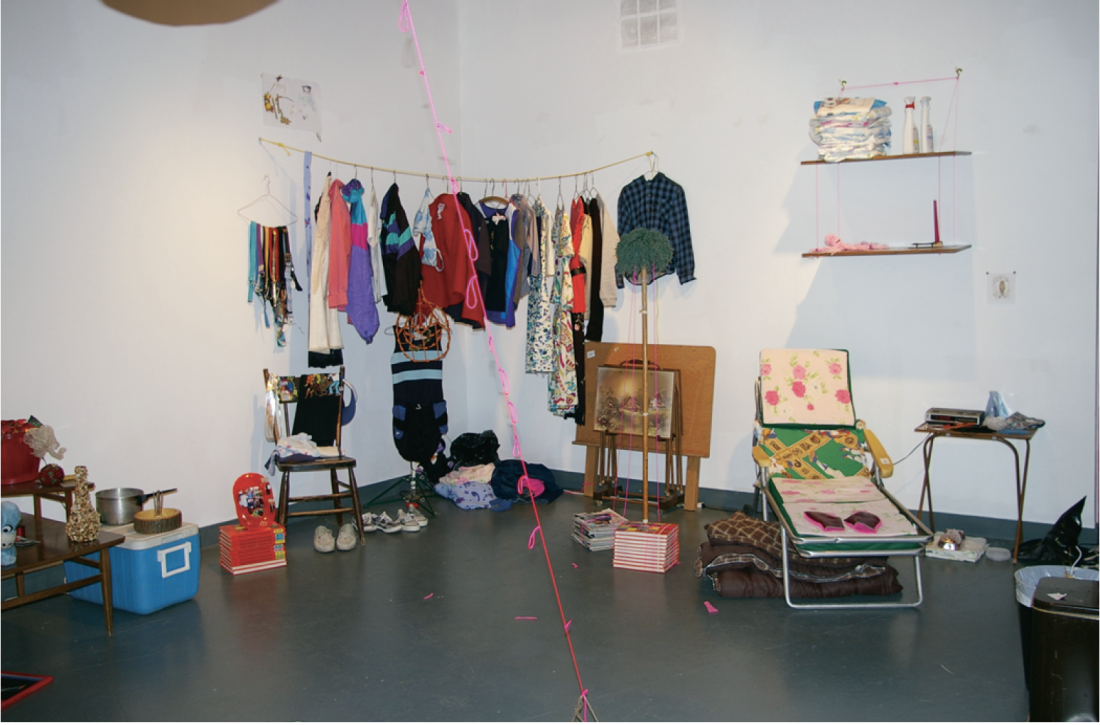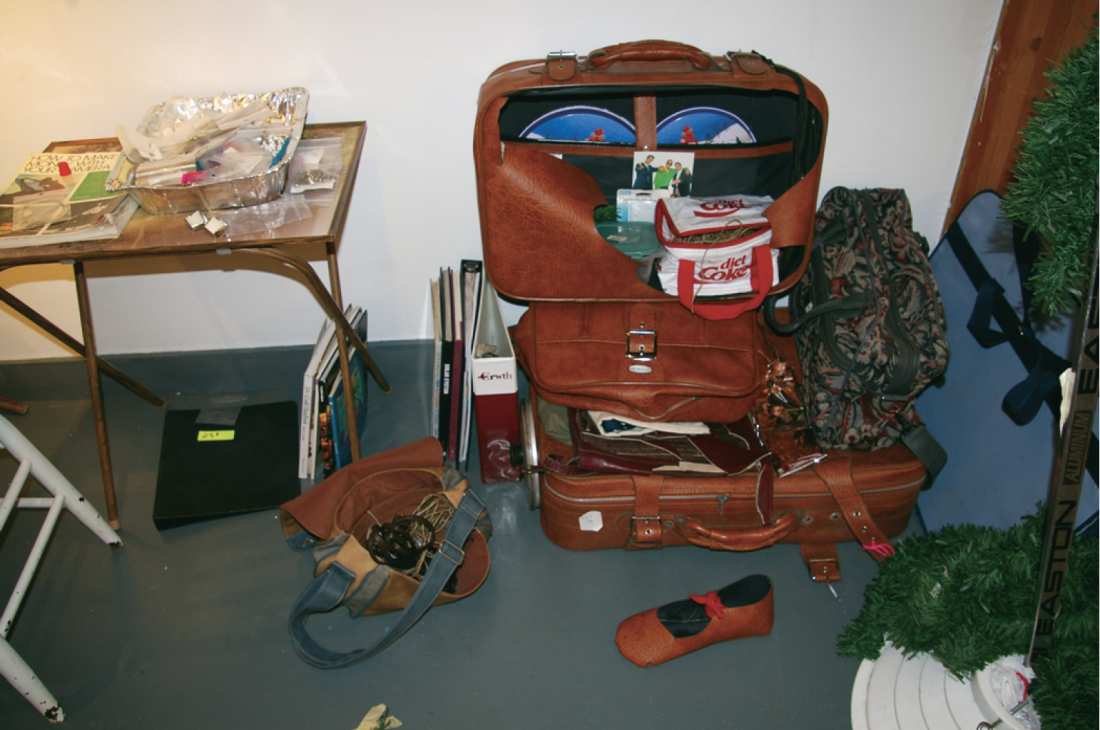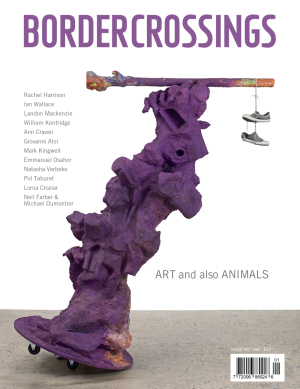Kara Uzelman
Walking into a garage sale, I always feel a bit seedy, like an insurance adjustor come to survey the remnants of a crime, or a dealer looking to scam the owner out of that vintage comic book he’s too unaware to properly appraise. It is intrusive. You’re exposed to too much personal information, allowed too far inside. Yet we’re not all the way in, just in the garage, the outer regions of domesticity where the relegated trinkets and bobbles of our collective experience lie moulting next to half-used cans of radiator fluid and mismatched cross-country skis. We are voyeurs titillated by our free pass to poke around someone’s stuff. And these places say so much about their proprietors. What kind of person would consent to have strangers scavenge through their things and quibble over the price of Johnny’s skates or Sara’s burned-out curling iron? It seems so callous to trade in the archival strata in which is deposited the family’s history.
In Kara Uzelman’s show “You look like you whereas I tend to look like me,” she recreates the curious habitat of the garage sale. Indeed, like a back-alley Charles Saatchi, she buys them up in their entirety. (I love the image of a young artist’s saying, “I’ll take the whole lot.”) Uzelman is acutely aware of the value of this familial documentation. According to her, these “collections provide an anthropological insight into the tastes, lifestyle, class, and failed or forgotten desires of the people selling them.” But unlike the arbiter of taste or fickle collector, Uzelman uses the platform of abandoned things to examine the residue of remembrance that lurks within them and manages to weave her own experience into their discarded remains.

Kara Uzelman, installation views of “you look like you whereas I tend to look like me,” 2005, Latitude 53, Edmonton. Photos: Laura Kozak. Courtesy Latitude 53.
Bottles covered in shells and shellac, poinsettia and plastic Christmas trees, plaid pencil cases, a stack of brilliant orange Funk and Wagnall’s Young Student’s Encyclopedia, TV-dinner trays picturing Constable-like landscapes: this is a world that somehow manages to describe elements of my past, the past of my friends, rumpus rooms and basements, spin-the-bottle, hidden passageways, being alone, being naughty. Carefully avoiding some snide indictment of suburban tackiness, Uzelman’s curiosity and receptivity are more anthropological, more nuanced than the sort of “mock valourization of banality” (to use Gary Michael Dault’s phrase) that is often associated with any close observation of white, working-class folk. The objects receiving Uzelman’s attention are both scrutinized and wonderfully, ambiguously embraced.
This is not a disinterested dramatization. The items are manipulated and arranged not only according to a visceral enjoyment of the relegated object, but also to a grander scheme, not unlike, say, Jessica Stockholder, but without the bombast. Her organization of materials is understated and sensitive, and she avoids treating the garage-sale objects simply as fodder for an overarching formal design. Allowing herself the freedom to interact with the items, Uzelman lets the relationships evolve and the narrative composition shift and change. I noticed a clever incident where she has cobbled a pair of elfin-like slippers. Upon further investigation, I found the evidence of her design cut out of a quite hideous vinyl suitcase. It is this sense of plumbing the articles for their innate metaphorical resonance, while also injecting her own personal narrative, that propels Uzelman’s approach.
And in case the viewer is unsure of her precarious position towards the objects, Uzelman provides clues that reveal her strategy. There is a photo album wrapped in a blue, quilted cover lying on the floor. With a slight hesitation I opened it to reveal a picture of a garage—presumably the garage— and pictures of Uzelman herself working through the project, along with diagrammatic illustrations mingled with abandoned photos of the sort Germaine Koh collects. Uzelman also makes enigmatic little drawings using pictures collaged from found books and magazines in that now familiar style of the Royal Art Lodge, whose aesthetic sensibilities must surely inform her own.

Kara Uzelman, installation views of “you look like you whereas I tend to look like me,” 2005, Latitude 53, Edmonton. Photos: Laura Kozak. Courtesy Latitude 53.
Sitting down and surveying the piece in its entirety, I could easily imagine myself lounging in someone’s basement suite. I am surrounded by the kind of improvised solutions to paucity that facilitate buying a ratty, old recliner, sewing two brown bunnies on its faded orange-brown fur, and thus transforming it into something funky and personal. I have always admired people, like my mother, who could rummage through junk and come out with something that, with a few deft stokes, becomes precious. This type of alchemy, however, is predicated on poverty. Many of the objects in this installation describe a world that is shabby, impecunious and sad. Take, for example, a certain aluminium lawn chair whose vinyl armature has been eroded and replaced with cardboard and pink and green cushions. There is a nasty brown sleeping bag folded underneath the makeshift single bed. This sleeping arrangement, only slightly removed from camping, speaks to me about the kind of sacrifices we make as artists, and the dearth and isolation that often accompany serious endeavour. I have slept on similar contraptions. Whether this lawn chair is a recreation from Uzelman’s own world or simply an object fabricated according to some other schema, it moves her exhibition from an intelligent assemblage of discarded things into an elegiac and thoughtful portrayal of the process of being an artist. ■
“You look like you whereas I tend to look like me” ran from September 9 to October 8, 2005, at Latitude 53, Edmonton, Alberta.
Sky Glabush is an artist and writer who lives in Edmonton.

